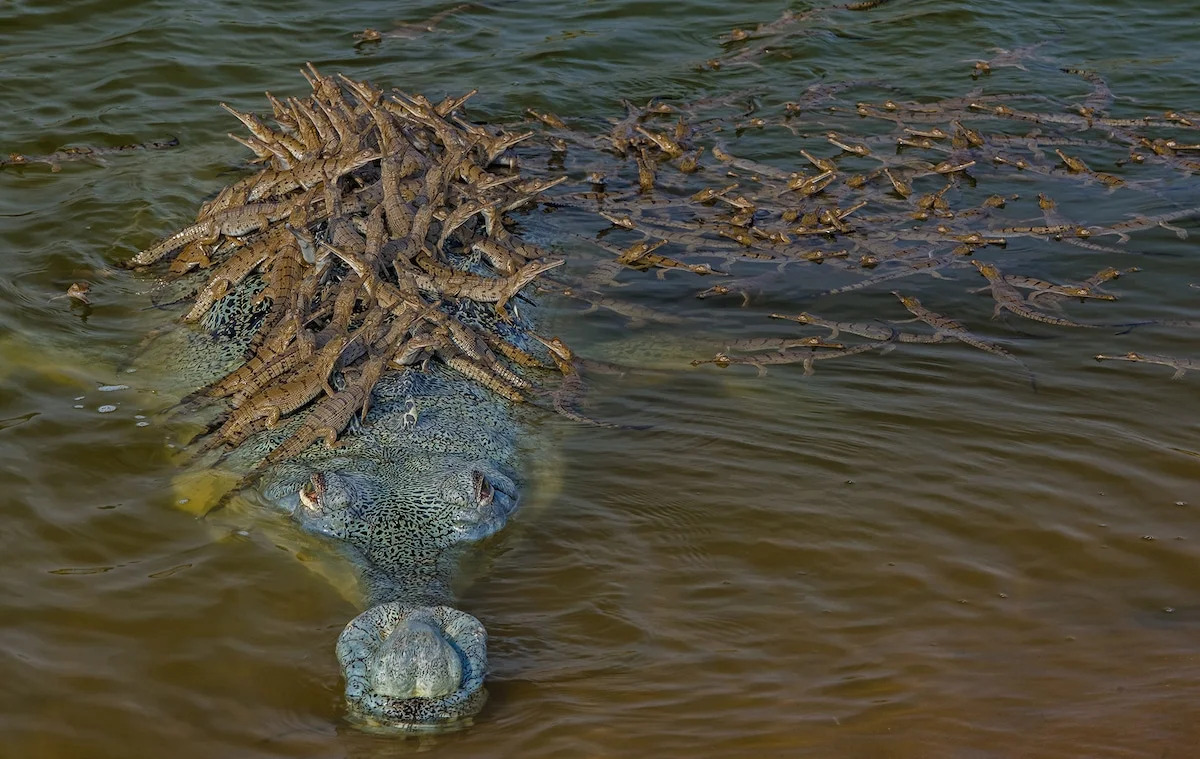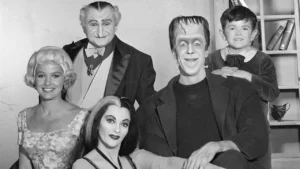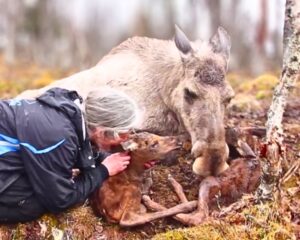Parenting in the wild is no easy task — especially when you’re a 15-foot crocodile carrying over 100 babies on your back. Yet, one rare gharial crocodile in India has stunned the world with his gentle care and remarkable dedication, showing that even the fiercest predators have a soft side.
This incredible image, captured by award-winning wildlife photographer Dhritiman Mukherjee, shows a male gharial patiently floating in the waters of India’s National Chambal Sanctuary, while more than 100 of his tiny offspring cling to his back.
It’s not just a viral photo — it’s a story of love, survival, and the challenges faced by one of the world’s most endangered reptiles.
🐊 What Makes This Gharial Father So Special
Unlike most crocodiles, gharials can’t carry their young in their mouths. Their long, narrow snouts — perfectly designed for catching fish — make that impossible. Instead, these fathers let their hatchlings cling to their backs and heads for safety, ferrying them through the rivers like a living raft.
According to Patrick Campbell, senior curator of reptiles at London’s Natural History Museum, “The gharial’s snout shape limits how it carries its young, so the babies depend on the father’s body for protection.”
This unique adaptation turns the gharial’s back into a nursery, shielding the hatchlings from predators, strong currents, and danger.
But what’s even more amazing?
Mukherjee revealed that this “superdad” mated with seven or eight females during the breeding season — leading to more than 100 baby gharials all looking to him for protection.
Now that’s commitment.
🌊 The Gharial: A Forgotten Giant of the River
Gharials are among the largest crocodilian species in the world, growing up to 15 feet long and weighing over 900 kilograms (2,000 pounds).
Named after the “ghara”, a pot-shaped bump that males have on their snouts, these crocs once thrived across South Asia’s major rivers.
Today, however, they are critically endangered.
Fewer than 650 adults remain in the wild, mostly in India and Nepal.
The biggest stronghold for these creatures is the National Chambal Sanctuary, where conservation teams protect breeding sites and monitor nests.
Unfortunately, gharials face numerous threats — habitat loss, sand mining, fishing nets, and polluted waters all pose serious dangers. Without strong conservation efforts, the species could vanish entirely within a generation.
🧬 A Rare Story of Hope
In an age where environmental decline dominates the news, this photo tells a different story — one of resilience and recovery.
Each of those baby gharials represents a glimmer of hope for the species. With proper conservation “treatment” and habitat protection, these hatchlings could one day rebuild the fragile gharial population.
Environmental researchers compare this work to a form of “wildlife insurance” — a necessary investment to protect nature’s most vulnerable lives before it’s too late. Just like taking out insurance for a home or mortgage protection, conservation is humanity’s way of safeguarding the planet’s assets.
📖 Read Full Story: Man Loses 360 Pounds Naturally – Internet Rallies to Support His Next Step
📸 The Photo That Captured the World
Mukherjee’s breathtaking shot was selected as one of the top 100 highly commended images in the Wildlife Photographer of the Year competition, hosted by the Natural History Museum of London.
Chosen from over 50,000 global entries, this photograph doesn’t just highlight technical skill — it captures the emotional bond between a father and his young, even in the most unexpected corners of nature.
The image is part of a traveling exhibition that reminds people everywhere why biodiversity matters — and why every species, from elephants to reptiles, deserves protection.
🌍 Lessons from Nature’s Single Dad
The gharial’s parenting story carries an important message about responsibility, balance, and care — not just in the wild, but in everyday life.
Here’s what we can learn:
✅ Protection takes strength: Just like a gharial shields its young, good financial habits (like strong credit management, reliable insurance, and smart loans) protect families in times of uncertainty.
✅ Sustainability matters: Conservation is a kind of long-term investment — like saving for a mortgage or planning for the future. The earlier we act, the better the outcome.
✅ Patience pays off: The gharial waits weeks for its eggs to hatch and carries its young daily. In life and finance alike, long-term patience builds real rewards.
This remarkable story proves that caring deeply — whether for your family, your planet, or your future — is what defines true strength.
💡 The Bigger Picture
While this story brings warmth, it also serves as a reminder that environmental recovery needs more attention and funding. Many wildlife organizations rely on donations, awareness campaigns, and environmental “treatment” programs to restore natural habitats.
The gharial’s comeback could mirror that of other endangered species — if we continue to support wildlife efforts and sustainable development.
There’s a lesson here for every industry too. Whether it’s a lawyer advocating for environmental policy, a software company creating data tools for conservation, or communities pooling resources for change — everyone has a role to play.
And just like this crocodile’s 100 tiny passengers, we all move forward more safely when we’re connected and protected.
📖 Read Full Story: The Hidden Meaning Behind Princess Diana’s Cannes Gown – A Heartfelt Farewell to Grace Kelly
🐊 Final Thoughts: Strength in Stillness
The image of a giant reptile calmly carrying 100 fragile lives on its back is more than wildlife photography — it’s a symbol.
It reminds us that even in the toughest environments, care, protection, and purpose still exist.
The gharial doesn’t roar or chase glory.
He simply carries the next generation forward — quietly, powerfully, and without hesitation.
That’s the essence of true guardianship — whether you’re managing a household, a business, a family loan, or even an environmental cause.
Because in nature, as in life, it’s not just about survival — it’s about support, protection, and legacy.
And for this fatherly gharial, that legacy swims right beside him — 100 tiny reminders that love, in any form, always finds a way.



